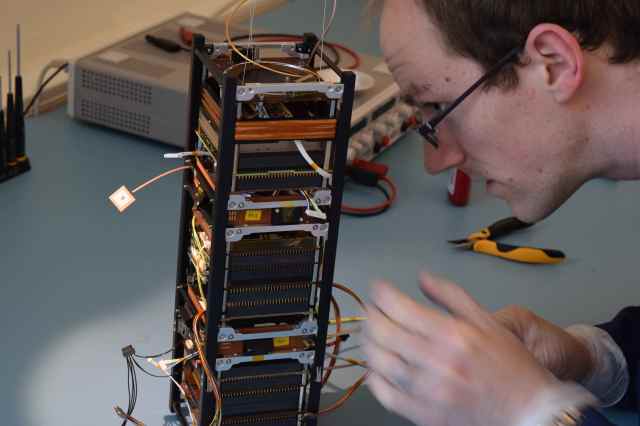Two Danish CubeSats carrying amateur radio payloads were successfully deployed from the International Space Station (ISS) on Monday, October 5 at 1405 UT.
Originally launched to the ISS on August 19, 2015, the two CubeSats, AAUSat-5 and GomX-3, were deployed from the ISS Japanese Kibo module airlock using the Kibo robotic arm.
After deployment the CubeSats stated transmitting signals to Earth that can be picked up by anyone with common amateur radio equipment. The frequencies to listen on are:
• AAUSat-5 – 437.425 MHz with 30 WPM CW beacon every 3 minutes and 9600 bps GMSK packet every 30 seconds
• GomX-3 – 437.250 MHz with 1200-9600 bps GMSK data using CSP protocol
AAUsat-5 is a 1-Unit CubeSat built by students at Aalborg University. The primary mission is to test an improved receiver for detecting Automatic Identification System (AIS) signals emitted by ships. Down on the ground, these signals are short-range, operating mainly on a ship-to-shore and ship-to-ship basis, leaving large spans of the world’s oceans uncovered. But signals also travel up to orbital altitude, opening up the prospect of worldwide monitoring.
GomX-3 is a 3-Unit CubeSat which aims to demonstrate new radio technology. A reconfigurable software-defined radio receiver will intercept L-band spot beams from telecom satellites in geostationary orbit, to provide independent measurements of their signal strength and quality. This receiver can also be repurposed to receive any other L-band signal, such as navigation satellite signals or radar beams.
A receiver will pick up Automatic Dependent Surveillance – Broadcast (ADS-B) signals automatically broadcast by civilian aircraft, to build up an overview of regional air traffic.
Additionally there is a high data rate X-band transmitter developed by Syrlinks. The CNES X-band ground station in Kourou, South America, will be used to demonstrate the link.
The GomX-3 amateur radio payload uses a NanoCom AX100 UHF transceiver and ANT430 antenna.
Mineo Wakita JE9PEL in Japan reported receiving the GomX-3 beacon in Japan from 1505-1510 UT on October 5 and Luciano Fabricio PY5LF reported hearing GomX-3 in Brazil at 1605 UT. Jan van Gills PE0SAT in the Netherlands received AAUSat-5 at 1800 UT.
The two spacecraft may have a lifetime of around 7 months before they burn up in the Earth’s atmosphere.
GomX-3 telemetry beacon https://www.dropbox.com/s/x4mipoz9gmqhlib/GOMX3_Beacon.pdf
AAUSat-5 telemetry beacon http://www.space.aau.dk/aausat5/index.php?n=Main.HamInfo
ESA article CubeSats set for Monday Release (with video)
http://www.esa.int/Our_Activities/Space_Engineering_Technology/ESA_CubeSats_set_for_Monday_release
ESA invites radio amateurs to listen for AAUSat-5 CubeSat
https://amsat-uk.org/2015/09/24/esa-listen-for-aausat-5/








You must be logged in to post a comment.